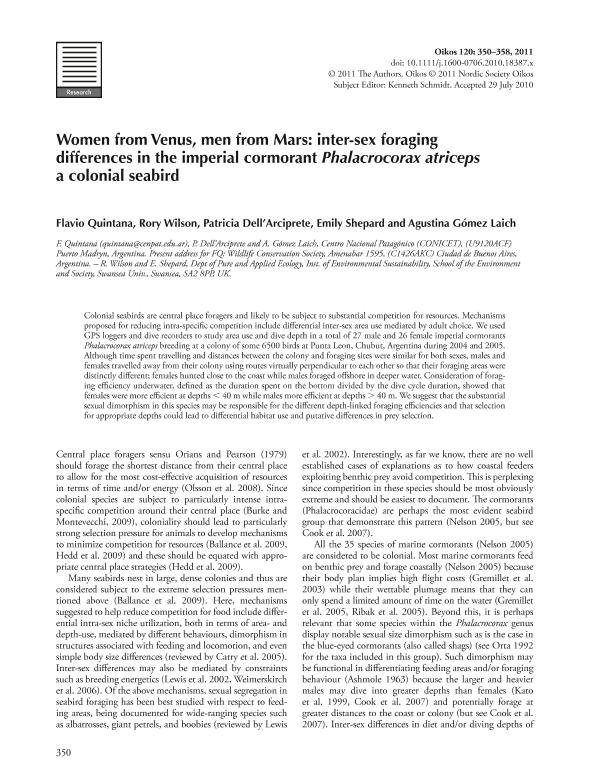Artículo
Women from Venus, men from Mars: Inter-sex foraging differences in the imperial cormorant Phalacrocorax atriceps a colonial seabird
Quintana, Flavio Roberto ; Wilson, Rory P.; Dell'arciprete, Olga Patricia
; Wilson, Rory P.; Dell'arciprete, Olga Patricia ; Shepard, Emily; Gómez Laich, Agustina Marta
; Shepard, Emily; Gómez Laich, Agustina Marta
 ; Wilson, Rory P.; Dell'arciprete, Olga Patricia
; Wilson, Rory P.; Dell'arciprete, Olga Patricia ; Shepard, Emily; Gómez Laich, Agustina Marta
; Shepard, Emily; Gómez Laich, Agustina Marta
Fecha de publicación:
03/2011
Editorial:
Wiley Blackwell Publishing, Inc
Revista:
Oikos
ISSN:
0030-1299
Idioma:
Inglés
Tipo de recurso:
Artículo publicado
Clasificación temática:
Resumen
Colonial seabirds are central place foragers and likely to be subject to substantial competition for resources. Mechanisms proposed for reducing intra-specific competition include differential inter-sex area use mediated by adult choice. We used GPS loggers and dive recorders to study area use and dive depth in a total of 27 male and 26 female imperial cormorants Phalacrocorax atriceps breeding at a colony of some 6500 birds at Punta Leon, Chubut, Argentina during 2004 and 2005. Although time spent travelling and distances between the colony and foraging sites were similar for both sexes, males and females travelled away from their colony using routes virtually perpendicular to each other so that their foraging areas were distinctly different; females hunted close to the coast while males foraged offshore in deeper water. Consideration of foraging efficiency underwater, defined as the duration spent on the bottom divided by the dive cycle duration, showed that females were more efficient at depths < 40 m while males more efficient at depths > 40 m. We suggest that the substantial sexual dimorphism in this species may be responsible for the different depth-linked foraging efficiencies and that selection for appropriate depths could lead to differential habitat use and putative differences in prey selection.
Palabras clave:
Imperial Cormorant
,
Sexual Dimorphism
,
Foraging Behaviour
,
Habitat Use
Archivos asociados
Licencia
Identificadores
Colecciones
Articulos(CCT-CENPAT)
Articulos de CTRO.CIENTIFICO TECNOL.CONICET - CENPAT
Articulos de CTRO.CIENTIFICO TECNOL.CONICET - CENPAT
Citación
Quintana, Flavio Roberto; Wilson, Rory P.; Dell'arciprete, Olga Patricia; Shepard, Emily; Gómez Laich, Agustina Marta; Women from Venus, men from Mars: Inter-sex foraging differences in the imperial cormorant Phalacrocorax atriceps a colonial seabird; Wiley Blackwell Publishing, Inc; Oikos; 120; 3; 3-2011; 350-358
Compartir
Altmétricas



